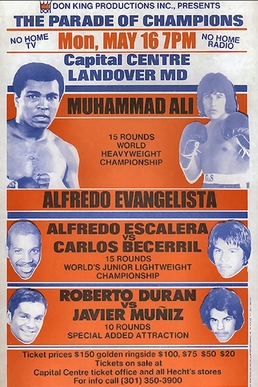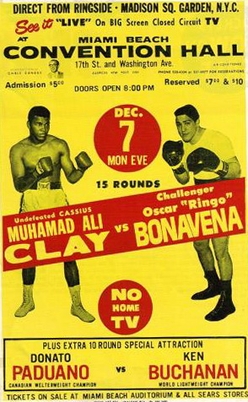
Muhammad Ali vs. Trevor Berbick, billed as "Drama in Bahama", was a ten-round boxing match that took place in Nassau, Bahamas on December 11, 1981. Ali was 39 years old at this time, and Berbick was 27 years old. The fight went the distance with Berbick winning through a unanimous decision on points. This was Ali's last boxing match.

Muhammad Ali vs. Chuck Wepner was a professional boxing match contested on March 24, 1975, for the undisputed heavyweight championship.
Muhammad Ali vs. Earnie Shavers was a professional boxing match contested on September 29, 1977, for the undisputed heavyweight championship.

Muhammad Ali vs. Ken Norton, billed as The Fight, was a professional boxing match contested on March 31, 1973, for the NABF heavyweight championship.
Muhammad Ali fought two boxing matches with George Chuvalo. The first bout took place on March 29, 1966; and the second on May 1, 1972. Chuvalo won both fights through Knockout.
Muhammad Ali and Karl Mildenberger fought for the world's heavyweight championship on September 10, 1966. The champion's sixth title defense since winning the world title in 1964, Ali stopped Mildenberger in the 12th round.
Muhammad Ali vs. Jean-Pierre Coopman was a professional boxing match contested on February 20, 1976, for the undisputed heavyweight championship. Ali won the fight after knocking out Coopman in the fifth round.
Muhammad Ali vs. Joe Bugner was a professional boxing match contested on February 14, 1973.
Muhammad Ali vs. Jimmy Young was a professional boxing match contested on April 30, 1976, for the undisputed heavyweight championship. Ali won the bout through a unanimous decision on points. This bout was aired live in primetime on ABC with Howard Cosell calling the action from the Capital Centre in Landover, Maryland.

Muhammad Ali vs. Alfredo Evangelista was a professional boxing match contested on May 16, 1977, for the undisputed heavyweight championship. Ali won the bout through a unanimous decision on points. The fight was held in the Capital Centre before a crowd of over 12,000 at the Capital Centre, along with a prime time broadcast on ABC.

Muhammad Ali vs. Bob Foster, billed as The Sound and the Fury, was a professional boxing match contested on November 21, 1972, for the NABF heavyweight championship.

Muhammad Ali vs. Oscar Bonavena was a professional boxing match contested on December 7, 1970, for the NABF and Lineal heavyweight championship at Madison Square Garden in New York City on December 7, 1970.
Muhammad Ali vs. Ernie Terrell was a professional boxing match contested on February 6, 1967, for the WBA, WBC, NYSAC, and The Ring heavyweight championships. The fight went 15 rounds, with Ali winning through a unanimous decision.
Muhammad Ali and Cleveland Williams fought each other in a boxing match at the Astrodome in Houston, Texas on November 14, 1966. Ali won the bout through a technical knockout in the third round. Many experts and boxers, including Mike Tyson, regard Ali's performance in this fight to be the finest of his boxing career. This was also the fight in which Ali made famous the move he called the "Ali shuffle".
Cassius Clay vs. Sonny Banks was a professional boxing match contested on February 10, 1962.
Cassius Clay fought Argentine Alex Miteff in a ten-round boxing match in Louisville on October 7, 1961. Clay won the fight through a technical knockout when the referee stopped the fight in the sixth round. Miteff and Clay would feature in the 1962 film Requiem for a Heavyweight.
Cassius Clay fought a ten-round boxing match with Tony Esperti in Miami on January 17, 1961. Clay won the bout through a technical knockout when the referee stopped the fight in the third round after Esparti's left eye had been cut by Clay's jabs. Esperti was later convicted of first degree murder for gunning down mafia boss Thomas Altamura, a member of the Gambino crime family.

Leon Spinks vs. Muhammad Ali II,, billed as Battle of New Orleans, was a professional boxing match contested on September 15, 1978, in New Orleans for the WBA and The Ring heavyweight championships.

Muhammad Ali was a boxer who mastered the rope-a-dope fighting technique. He is widely regarded by many boxing commentators and historians as the greatest heavyweight boxer of all time. Boxing magazine The Ring named him number one in a 1998 ranking of greatest heavyweights from all eras. In 1999, The Associated Press voted Ali the number one heavyweight of the 20th century.
Muhammad Ali vs. Joe Bugner II was a professional boxing match contested on 1 July 1975, for the undisputed heavyweight championship.








